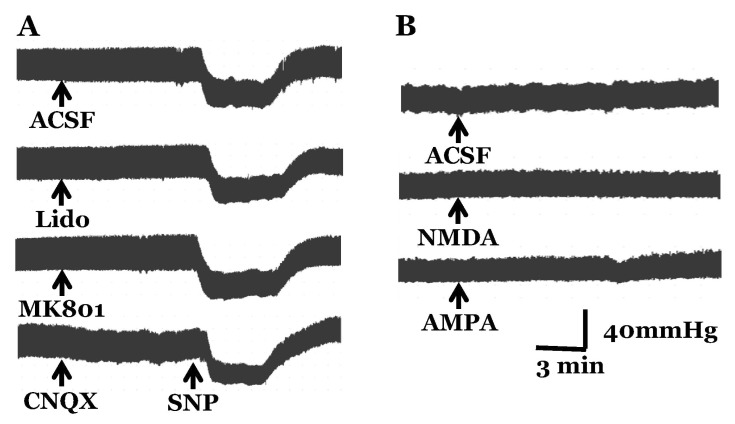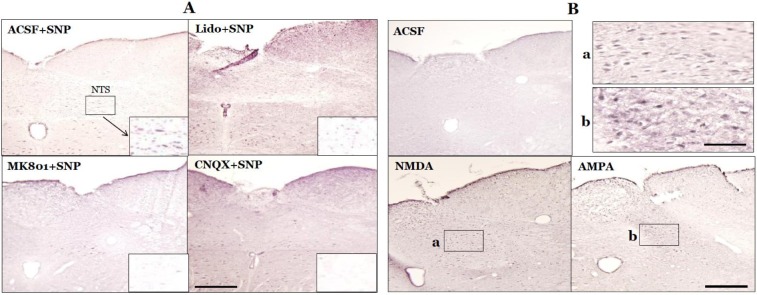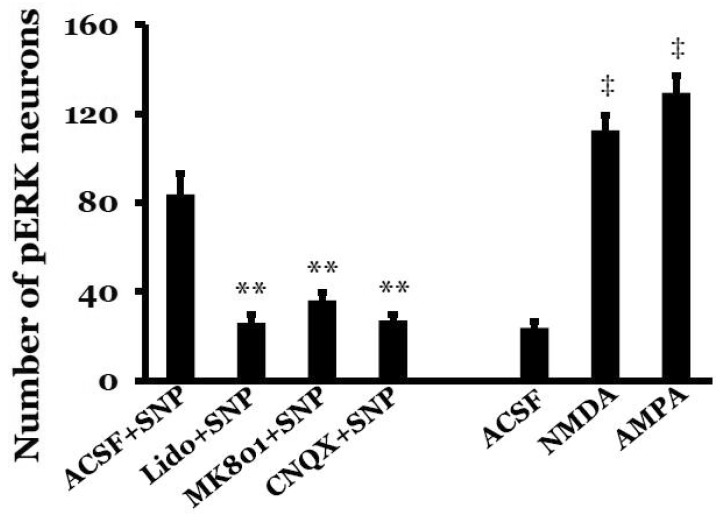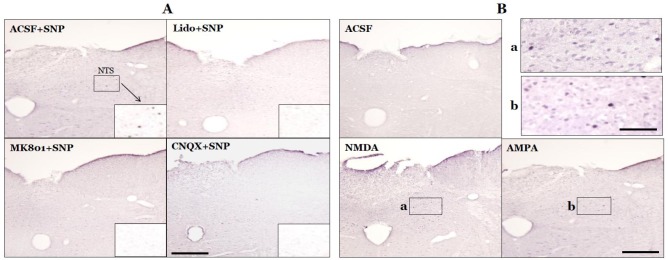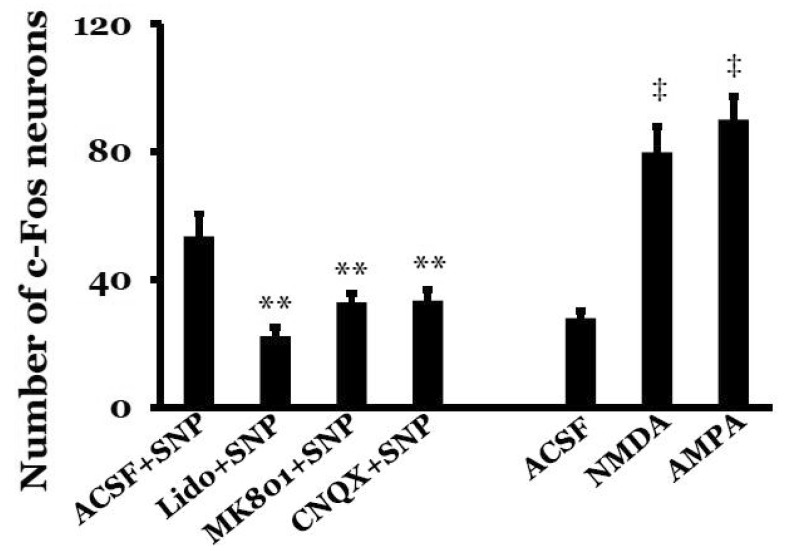Korean J Physiol Pharmacol.
2015 May;19(3):275-281. 10.4196/kjpp.2015.19.3.275.
Effect of Glutamate on the Vestibulo-Solitary Projection after Sodium Nitroprusside-Induced Hypotension in Conscious Rats
- Affiliations
-
- 1Department of Physiology and Pathophysiology, Yanbian University College of Medicine, Yanji 133002, China. y-z-jin@ybu.edu.cn
- 2Department of Cerebral Surgery, Yanbian University College of Clinical Medicine, Yanji 133000, China.
- 3Department of Physiology, Wonkwang University School of Medicine and Brain Science Institute at Wonkwang University, Iksan 570-749, Korea. byungp@wku.ac.kr
- 4University of Baghdad College of Medicine, Baghdad Medical City, Baghdad 10071, Iraq.
- KMID: 1791430
- DOI: http://doi.org/10.4196/kjpp.2015.19.3.275
Abstract
- Orthostatic hypotension is most common in elderly people, and its prevalence increases with age. Attenuation of the vestibulo-sympathetic reflex (VSR) is commonly associated with orthostatic hypotension. In this study, we investigated the role of glutamate on the vestibulo-solitary projection of the VSR pathway to clarify the pathophysiology of orthostatic hypotension. Blood pressure and expression of both pERK and c-Fos protein were evaluated in the nucleus tractus solitarius (NTS) after microinjection of glutamate into the medial vestibular nucleus (MVN) in conscious rats with sodium nitroprusside (SNP)-induced hypotension that received baroreceptor unloading via sinoaortic denervation (SAD). SNP-induced hypotension increased the expression of both pERK and c-Fos protein in the NTS, which was abolished by pretreatment with glutamate receptor antagonists (MK801 or CNQX) in the MVN. Microinjection of glutamate receptor agonists (NMDA or AMPA) into the MVN increased the expression of both pERK and c-Fos protein in the NTS without causing changes in blood pressure. These results indicate that both NMDA and AMPA receptors play a significant role in the vestibulo-solitary projection of the VSR pathway for maintaining blood pressure, and that glutamatergic transmission in this projection might play a key role in the pathophysiology of orthostatic hypotension.
Keyword
MeSH Terms
-
Aged
Animals
Blood Pressure
Denervation
Excitatory Amino Acid Antagonists
Glutamic Acid*
Humans
Hypotension*
Hypotension, Orthostatic
Microinjections
N-Methylaspartate
Nitroprusside
Pressoreceptors
Prevalence
Rats*
Receptors, AMPA
Receptors, Glutamate
Reflex
Sodium*
Solitary Nucleus
Vestibular Nuclei
Excitatory Amino Acid Antagonists
Glutamic Acid
N-Methylaspartate
Nitroprusside
Receptors, AMPA
Receptors, Glutamate
Sodium
Figure
Cited by 2 articles
-
Functional Connections of the Vestibulo-spino-adrenal Axis in the Control of Blood Pressure Via the Vestibulosympathetic Reflex in Conscious Rats
Huan-Jun Lu, Mei-Han Li, Mei-Zhi Li, Sang Eon Park, Min Sun Kim, Yuan-Zhe Jin, Byung Rim Park
Korean J Physiol Pharmacol. 2015;19(5):427-434. doi: 10.4196/kjpp.2015.19.5.427.Role of peripheral vestibular receptors in the control of blood pressure following hypotension
Guang-Shi Jin, Xiang-Lan Li, Yuan-Zhe Jin, Min Sun Kim, Byung Rim Park
Korean J Physiol Pharmacol. 2018;22(4):363-368. doi: 10.4196/kjpp.2018.22.4.363.
Reference
-
1. Kaufmann H. Consensus statement on the definition of orthostatic hypotension, pure autonomic failure and multiple system atrophy. Clin Auton Res. 1996; 6:125–126. PMID: 8726100.2. Freeman R. Clinical practice. Neurogenic orthostatic hypotension. N Engl J Med. 2008; 358:615–624. PMID: 18256396.3. Yates BJ. Vestibular influences on the sympathetic nervous system. Brain Res Brain Res Rev. 1992; 17:51–59. PMID: 1638275.
Article4. Doba N, Reis DJ. Role of the cerebellum and the vestibular apparatus in regulation of orthostatic reflexes in the cat. Circ Res. 1974; 40:9–18.
Article5. Dampney RA, Polson JW, Potts PD, Hirooka Y, Horiuchi J. Functional organization of brain pathways subserving the baroreceptor reflex: studies in conscious animals using immediate early gene expression. Cell Mol Neurobiol. 2003; 23:597–616. PMID: 14514018.6. Balaban CD, Beryozkin G. Vestibular nucleus projections to nucleus tractus solitarius and the dorsal motor nucleus of the vagus nerve: potential substrates for vestibulo-autonomic interactions. Exp Brain Res. 1994; 98:200–212. PMID: 8050507.
Article7. Yates BJ, Grélot L, Kerman IA, Balaban CD, Jakus J, Miller AD. Organization of vestibular inputs to nucleus tractus solitarius and adjacent structures in cat brain stem. Am J Physiol. 1994; 267:R974–R983. PMID: 7524372.
Article8. Lan Y, Yang YZ, Jiang X, Li LW, Jin GS, Kim MS, Park BR, Jin YZ. Additive role of the vestibular end organ and baroreceptors on the regulation of blood pressure in rats. Korean J Physiol Pharmacol. 2013; 17:367–373. PMID: 23946697.
Article9. Jiang X, Li LW, Lan Y, Yang YZ, Jin GS, Kim MS, Park BR, Jin YZ. Comparative analysis of vestibular receptor and baroreceptor inputs to the nucleus tractus solitarius following acute hypotension in conscious rats. Neurosci Lett. 2014; 563:70–74. PMID: 24486893.
Article10. Weston M, Wang H, Stornetta RL, Sevigny CP, Guyenet PG. Fos expression by glutamatergic neurons of the solitary tract nucleus after phenylephrine-induced hypertension in rats. J Comp Neurol. 2003; 460:525–541. PMID: 12717712.
Article11. Park BR, Kim MS, Kim JH, Jin YZ. Effects of acute hypotension on neuronal activity in the medial vestibular nuclei of rats. Neuroreport. 2001; 12:3821–3824. PMID: 11726802.
Article12. Kim MS, Hyo Kim J, Kry D, Ae Choi M, Ok Choi D, Gon Cho B, Jin YZ, Ho Lee S, Park BR. Effects of acute hypotension on expression of cFos-like protein in the vestibular nuclei of rats. Brain Res. 2003; 962:111–121. PMID: 12543461.
Article13. Choi MA, Lee JH, Hwang JH, Choi SJ, Kim MS, Park BR. Signaling pathway of glutamate in the vestibular nuclei following acute hypotension in rats. Brain Res. 2008; 1229:111–117. PMID: 18639534.
Article14. Li XL, Nian B, Jin Y, Li LW, Jin GS, Kim MS, Park BR, Jin YZ. Mechanism of glutamate receptor for excitation of medial vestibular nucleus induced by acute hypotension. Brain Res. 2012; 1443:27–33. PMID: 22305141.
Article15. Li XL, An Y, Jin QH, Kim MS, Park BR, Jin YZ. Changes of some amino acid concentrations in the medial vestibular nucleus of conscious rats following acute hypotension. Neurosci Lett. 2010; 477:11–14. PMID: 20399837.
Article16. Morgan JI, Curran T. Stimulus-transcription coupling in the nervous system: involvement of the inducible proto-oncogenes fos and jun. Annu Rev Neurosci. 1991; 14:421–451. PMID: 1903243.
Article17. Sgambato V, Pagès C, Rogard M, Besson MJ, Caboche J. Extracellular signal-regulated kinase (ERK) controls immediate early gene induction on corticostriatal stimulation. J Neurosci. 1998; 18:8814–8825. PMID: 9786988.
Article18. Chan RK, Peto CA, Sawchenko PE. Fine structure and plasticity of barosensitive neurons in the nucleus of solitary tract. J Comp Neurol. 2000; 422:338–351. PMID: 10861511.
Article19. Wei S, Lei M, Tong M, Ding J, Han Q, Xiao M. Acute baroreceptor unloading evokes Fos expression in anesthetized rat brain. Brain Res Bull. 2008; 76:63–69. PMID: 18395612.
Article20. Paxinos G, Watson C. The Rat Brain in Stereotaxic Coordinates. Orlando, FL, USA: Academic Press;2007.21. Kim MS, Choi DO, Choi MA, Kim JH, Kim KY, Lee MY, Rhee JK, Chun SW, Park BR. Immunohistochemical detection of phosphorylated form of extracellular signal-regulated kinase 1/2 in rat vestibular nuclei following hemorrhagic hypotension. Neurosci Lett. 2004; 360:49–52. PMID: 15082176.
Article22. Jiang X, Lan Y, Jin YZ, Park JY, Park BG, Ameer AN, Park BR. Effect of vestibulosympathetic reflex and baroreflex on expression of pERK in the nucleus tractus solitarius following acute hypotension in conscious rats. Korean J Physiol Pharmacol. 2014; 18:353–358. PMID: 25177169.
Article23. Kalia M, Mesulam MM. Brain stem projections of sensory and motor components of the vagus complex in the cat: II. Laryngeal, tracheobronchial, pulmonary, cardiac, and gastrointestinal branches. J Comp Neurol. 1980; 193:467–508. PMID: 7440778.
Article24. Holstein GR, Friedrich VL Jr, Martinelli GP. Projection neurons of the vestibulo-sympathetic reflex pathway. J Comp Neurol. 2014; 522:2053–2074. PMID: 24323841.
Article25. Murad F. Cyclic guanosine monophosphate as a mediator of vasodilation. J Clin Invest. 1986; 78:1–5. PMID: 2873150.
Article26. Kerman IA, Yates BJ. Regional and functional differences in the distribution of vestibulosympathetic reflexes. Am J Physiol. 1998; 275:R824–R835. PMID: 9728081.
- Full Text Links
- Actions
-
Cited
- CITED
-
- Close
- Share
- Similar articles
-
- The Cardiovascular and Intracranial Effects of Isoflurane, Sodium Nitroprusside, and Labetalol-Induced Hypotension in Cats
- The Effects of Sodium Nitroprusside and Prostaglandin E Induced - Hypotension to Baroreceptor Reflex
- Functional Connections of the Vestibulo-spino-adrenal Axis in the Control of Blood Pressure Via the Vestibulosympathetic Reflex in Conscious Rats
- Dual control of the vestibulosympathetic reflex following hypotension in rats
- Effect of Clonidine Premedication on Isoflurane Induced Hypotensive Anesthesia

